Lesson Plan for Lesson 32
A lesson plan for lesson 32 in The Catholic Faith Handbook for Youth: Catechist Guide. In this lesson students explore what it means to use virtues and grace to live a moral life.
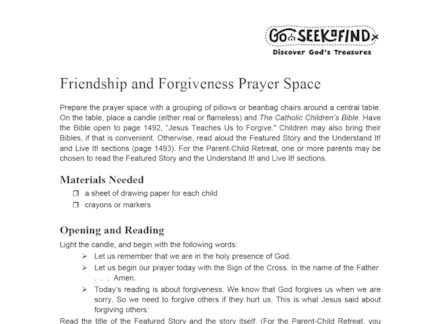
An activity, including a discussion and a craft, on forgiving friends and family members, based on The Catholic Children’s Bible featured story “Jesus Teaches Us to Forgive”, Matthew 18:21–35.
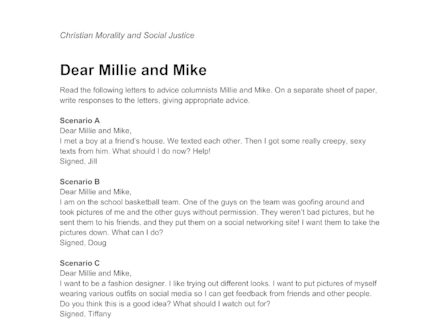
This handout provides several real-life situations that teens might encounter. Students are challenged to respond to the situations and give advice to other teens.
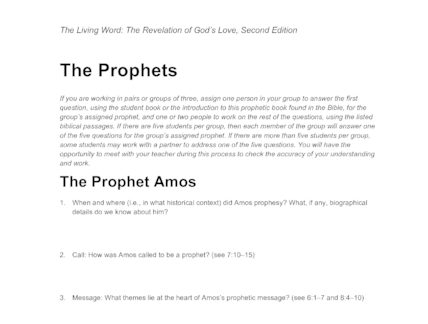
This small-group activity provides questions for students to answer about the different prophetic books of the bible.
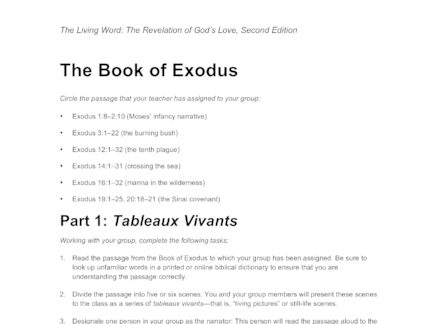
This small-group project asks students to read a section from the Book of Exodus before acting out the passage and responding to discussion questions.
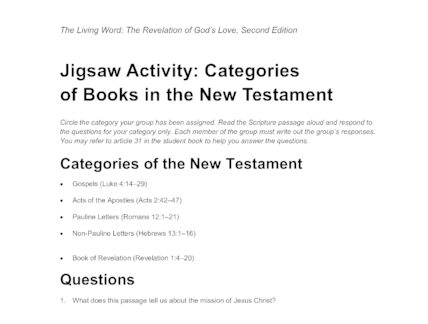
This activity asks small groups to answer questions about a specific section of the New Testament.
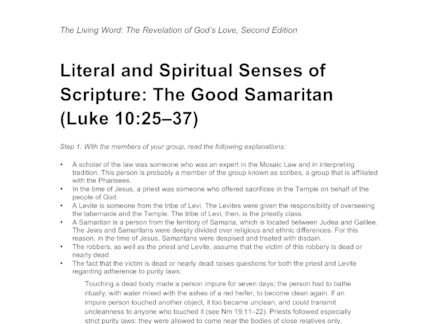
This small-group, discussion guide challenges students to read a familiar story using a different lense and perspective.
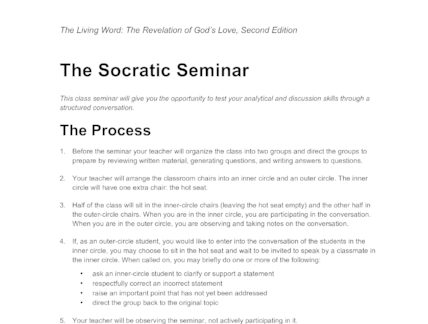
This handout provides a set of guidelines and instructions to help students successfully participate in a Socratic seminar.
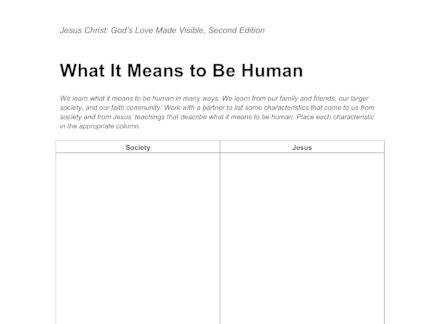
This handout helps students list characteristics that come from society and from Jesus’ teachings that describe what it means to be human.
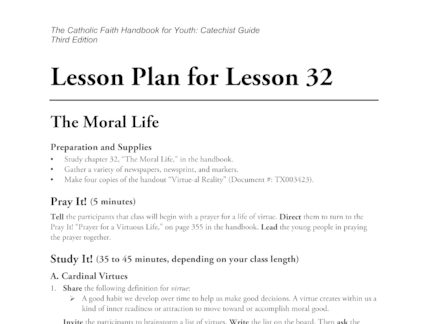
A lesson plan for lesson 32 in The Catholic Faith Handbook for Youth: Catechist Guide. In this lesson students explore what it means to use virtues and grace to live a moral life.
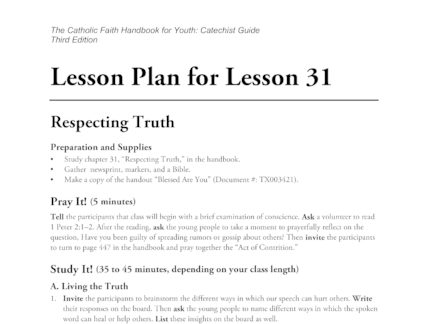
A lesson plan for lesson 31 in The Catholic Faith Handbook for Youth: Catechist Guide. In this lesson students explore what it means to respect truth.
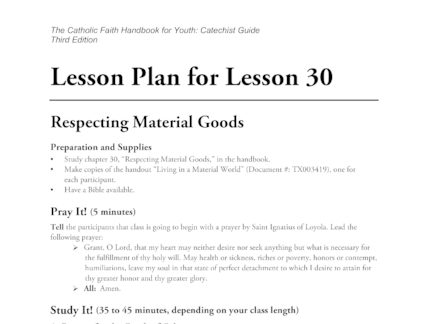
A lesson plan for lesson 30 in The Catholic Faith Handbook for Youth: Catechist Guide. In this lesson students explore what it means to respect material goods.
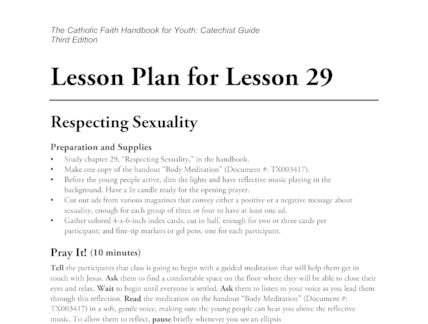
A lesson plan for lesson 29 in The Catholic Faith Handbook for Youth: Catechist Guide. In this lesson students explore what it means to respect the sexuality of ourselves and others.
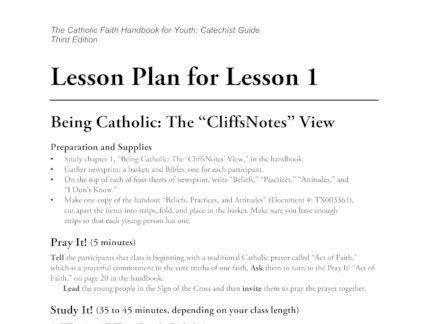
A lesson plan for lesson 1 in The Catholic faith Handbook for Youth: Catechist Guide. This lesson plan challenges students to identify why they are Catholic and the core beliefs, practices, and attitudes of Catholicism
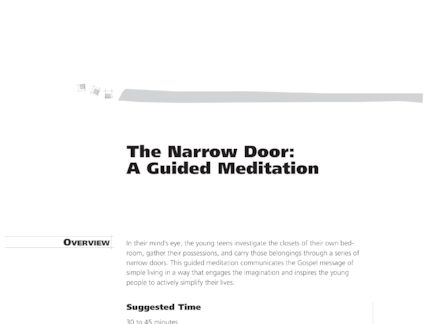
This guided meditation communicates the Gospel message of simple living in a way that engages the imagination and inspires young people to actively simplify their lives. This activity is an excerpt from the book Justice and Service Ideas for Ministry …
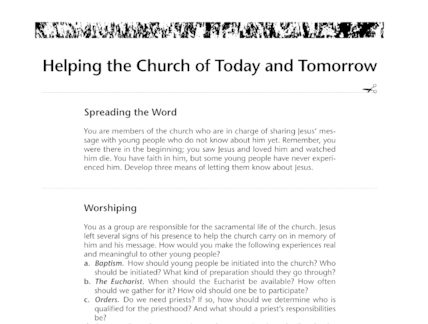
This handout challenges students to reflect on and brainstorm what it would have been like to create Church teachings and rules shortly after Jesus’ death and resurrection.
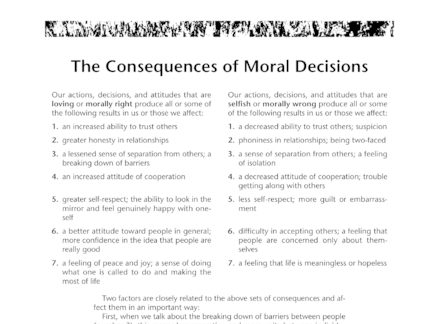
This handout examines how actions, attitudes, and decisions affect ourselves and the people around us
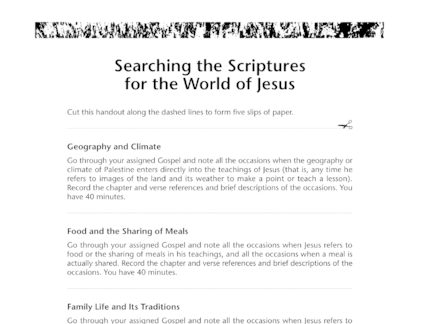
Small-group activity that guides students to discover the culture of Jesus’ world by searching the Gospels
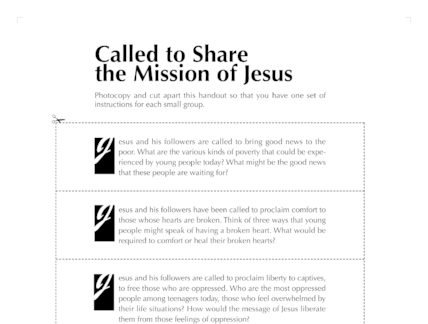
This small-group activity provides each group with an example of Christ's mission. Groups must answer questions surrounding their particular example.
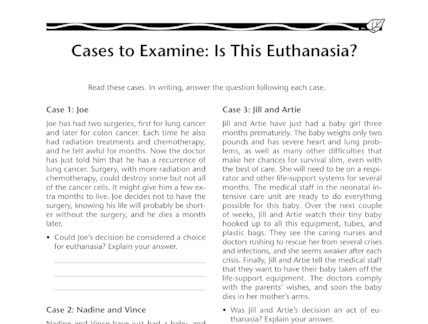
This handout provides three situations for students to read and evaluate. Students must decide if the story shows an example of Euthanasia.
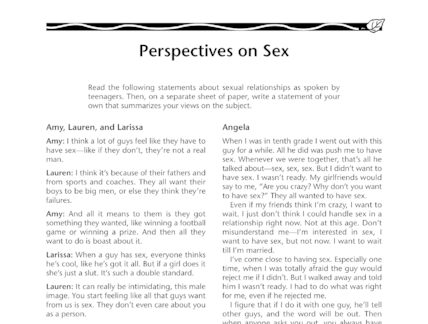
This handout provides several comments from teenagers about sex. It can be used as a discussion starter or writing prompt.
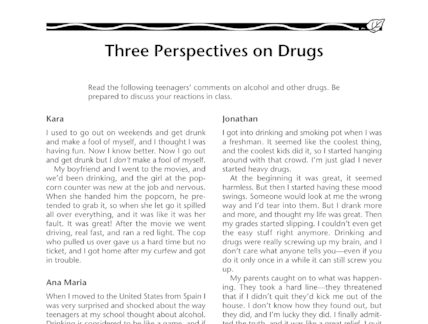
This handout provides three different comments from teens about their drug and alcohol usage. This can be used as a discussion starter.
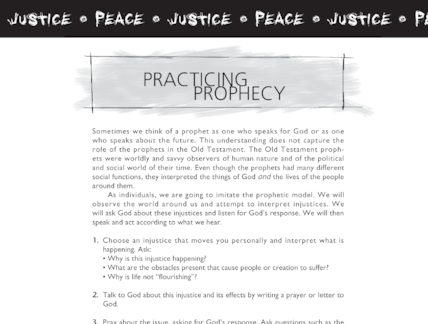
An activity where students are given the opportunity to imitate the prophetic model by observing the world around them and attempting to interpret injustices.
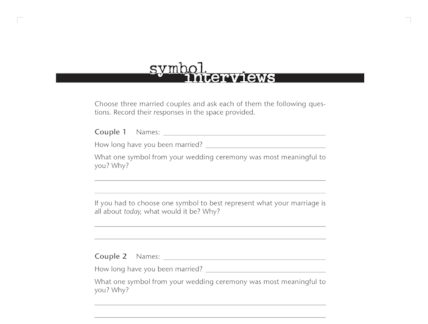
A series of interview questions that students can ask married couples about symbols and marriage.
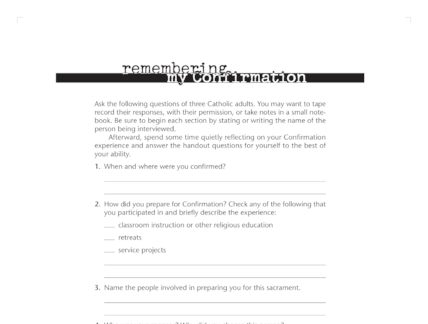
A worksheet where students are asked to interview several adults about their Confirmation experiences.
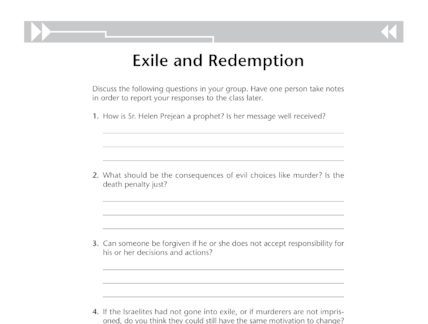
Discuss the following questions in your group. Have one person take notes in order to report your responses to the class later.
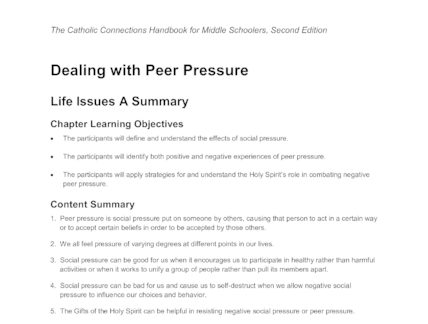
A good summary on dealing with peer pressure.
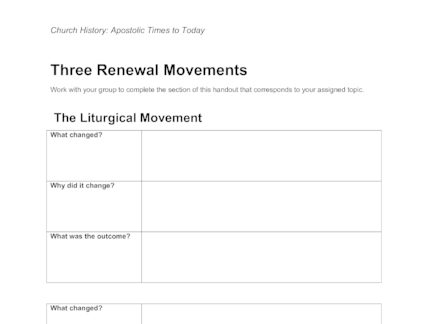
Work with your group to complete the section of this handout that corresponds to your assigned topic.
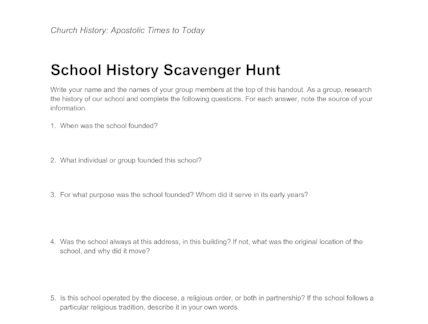
Write your name and the names of your group members at the top of this handout. As a group, research the history of our school and complete the following questions. For each answer, note the source of your information. This …
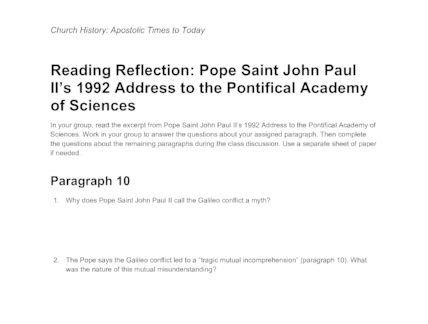
In your group, read the excerpt from Pope Saint John Paul II’s 1992 Address to the Pontifical Academy of Sciences. Work in your group to answer the questions about your assigned paragraph. Then complete the questions about the remaining paragraphs …
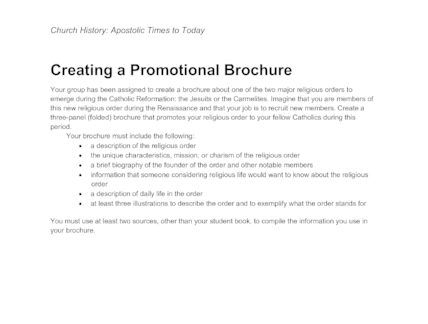
Your group has been assigned to create a brochure about one of the two major religious orders to emerge during the Catholic Reformation: the Jesuits or the Carmelites. Imagine that you are members of this new religious order during the …
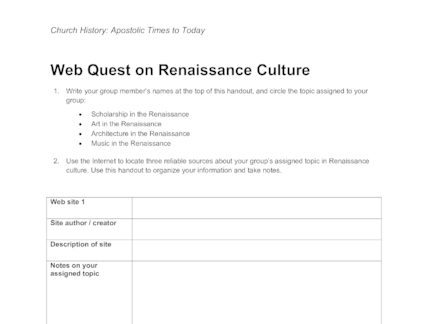
Write your group member’s names at the top of this handout, and circle the topic assigned to your group. Use the Internet to locate three reliable sources about your group’s assigned topic in Renaissance culture. Use this handout to organize …
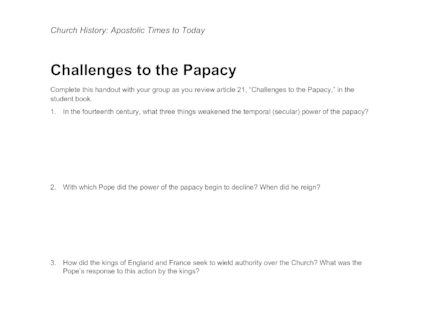
Complete this handout with your group as you review article 21, “Challenges to the Papacy,” in the student book.
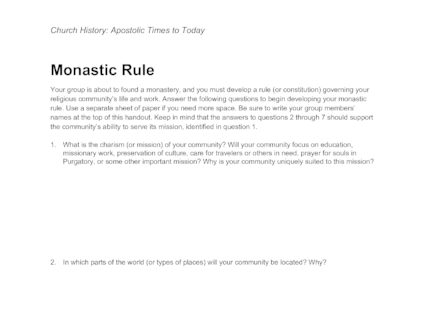
Your group is about to found a monastery, and you must develop a rule (or constitution) governing your religious community’s life and work. Answer the following questions to begin developing your monastic rule. Use a separate sheet of paper if …
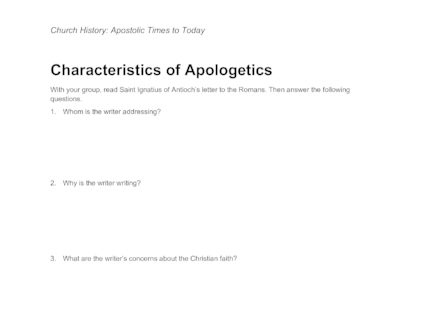
With your group, read Saint Ignatius of Antioch’s letter to the Romans. Then answer the following questions.
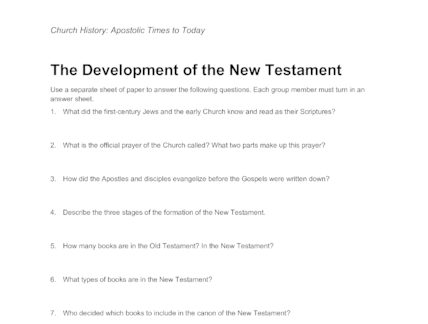
Use a separate sheet of paper to answer the following questions. Each group member must turn in an answer sheet.
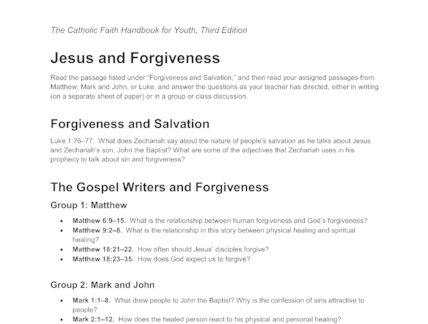
Read the passage listed under “Forgiveness and Salvation,” and then read your assigned passages from Matthew, Mark and John, or Luke, and answer the questions as your teacher has directed, either in writing (on a separate sheet of paper) or …
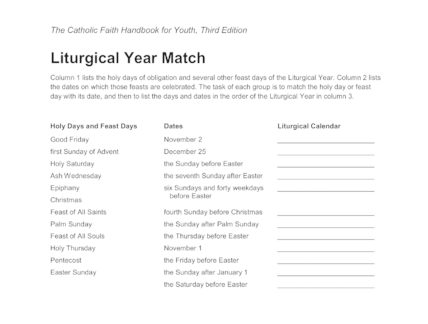
Column 1 lists the holy days of obligation and several other feast days of the Liturgical Year. Column 2 lists the dates on which those feasts are celebrated. The task of each group is to match the holy day or …
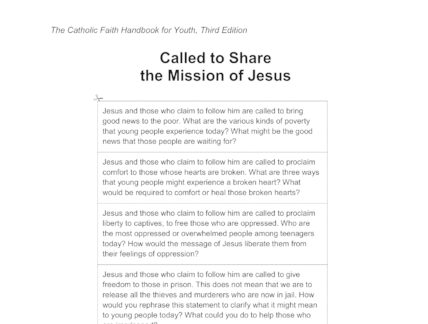
Questions about how we can imitate Jesus’ example in the way we interact with others.
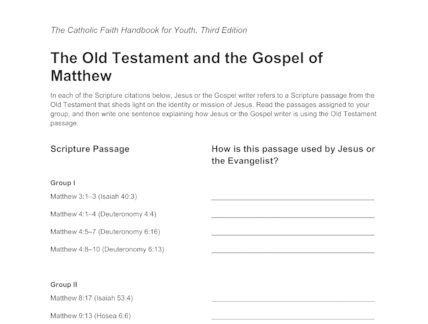
In each of the Scripture citations below, Jesus or the Gospel writer refers to a Scripture passage from the Old Testament that sheds light on the identity or mission of Jesus. Read the passages assigned to your group, and then …
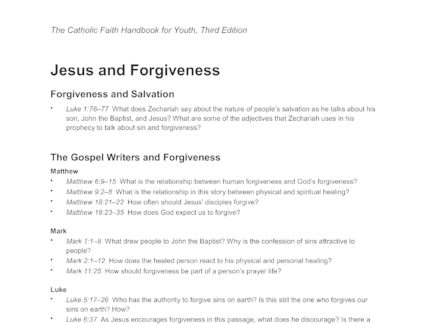
Questions about Scripture verses that talk about forgiveness and salvation.
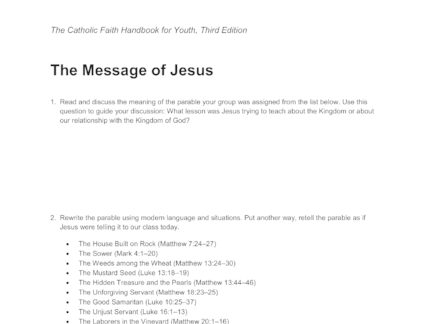
Read and discuss the meaning of the parable your group was assigned from the list below. Use this question to guide your discussion: What lesson was Jesus trying to teach about the Kingdom or about our relationship with the Kingdom …
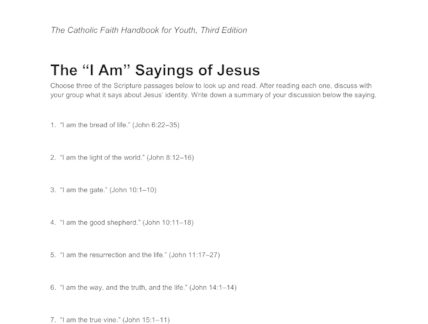
Choose three of the Scripture passages below to look up and read. After reading each one, discuss with your group what it says about Jesus’ identity. Write down a summary of your discussion below the saying.
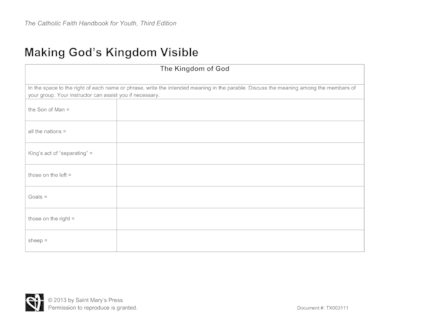
In the space to the right of each name or phrase, write the intended meaning in the parable. Discuss the meaning among the members of your group. Your instructor can assist you if necessary. Describe people or groups that these …
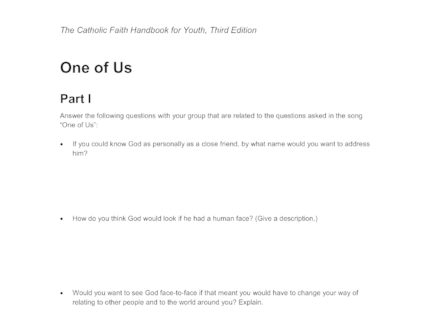
Answer the following questions with your group that are related to the questions asked in the song “One of Us”. Your instructor will lead you through Part II. Use the following questions as prompts for taking notes in your notebook.
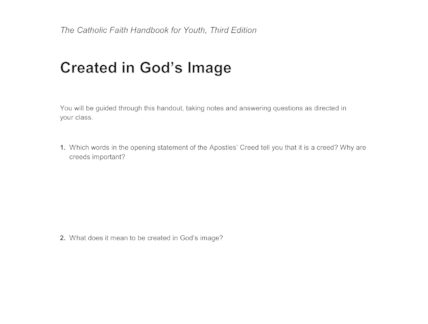
You will be guided through this handout, taking notes and answering questions as directed in your class.
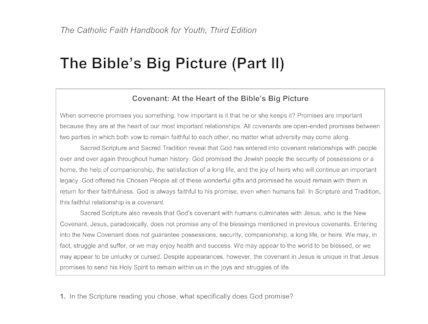
A description of what a Covenant is, and discussion questions about God’s promises.
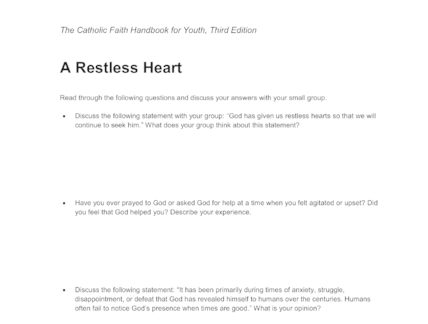
Read through the following questions and discuss your answers with your small group.
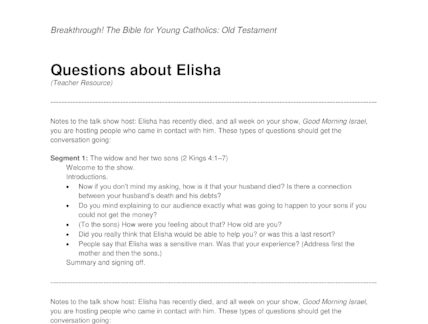
An activity in the form of a talk show, Good Morning Israel, about the death of Elisha and interviewing people who came in contact with him.
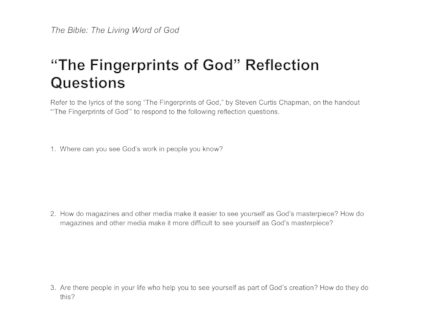
A set of reflection questions on the song, “The Fingerprints of God” by Steven Curtis Chapman.
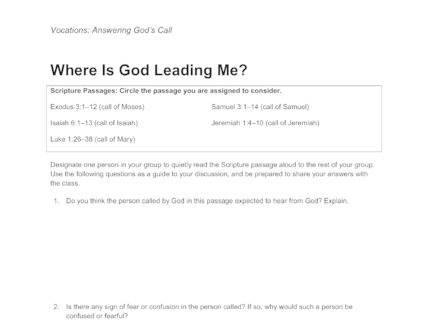
A discussion oriented worksheet that includes meditating on scripture passages and answering questions about the readings as well as personal questions.
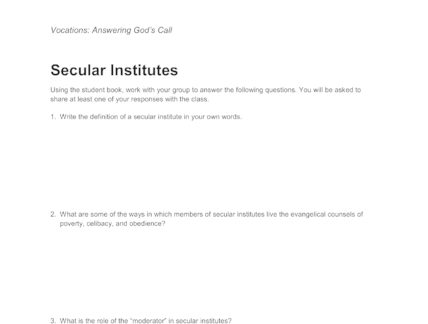
A worksheet completed in groups about the history, role, and characteristics of secular institutes.
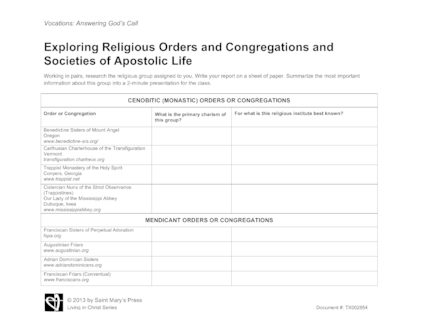
A research assignment worksheet done in pairs to find important information about different religious orders.
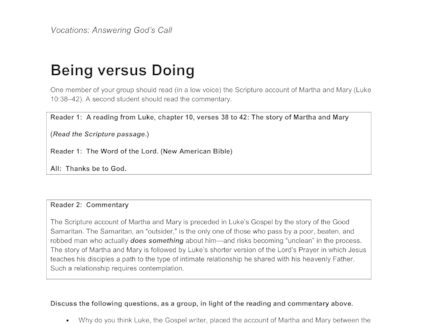
A scripture passage from the Gospel of Luke about Martha and Mary is read along with a commentary, and is followed by large group discussion questions.
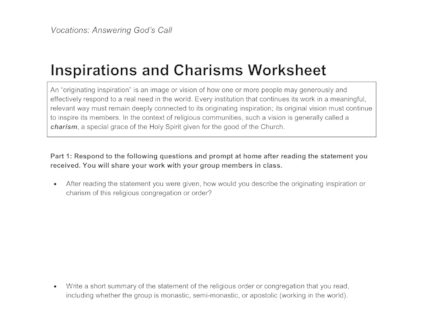
A partially independent and partially group completed worksheet for students to fill out about the inspirations and charisms of a particular religious congregation or order.
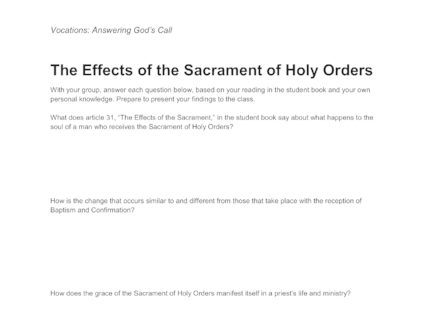
A worksheet completed in groups about the effects of the Sacrament of Holy Orders from both the book and the student’s personal knowledge.
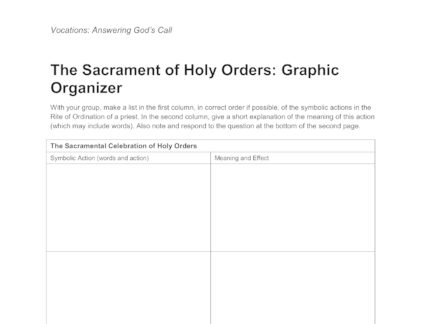
A worksheet completed in groups about the symbolic words and actions that take place during the Rite of Ordination, as well as their meaning and effect.
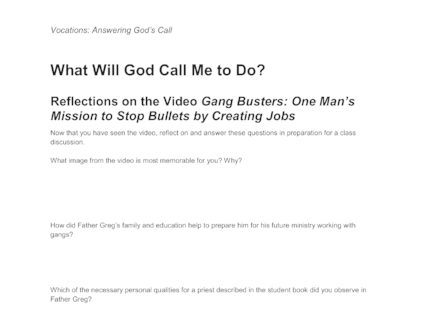
A reflection worksheet and class discussion on the video Gang Busters: One Man’s Mission to Stop Bullets by Creating Jobs.
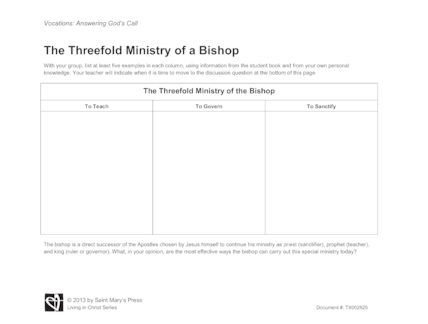
This resource is a group activity worksheet that has students list examples of the Bishop’s roles in the areas of teaching, governing, and sanctifying.
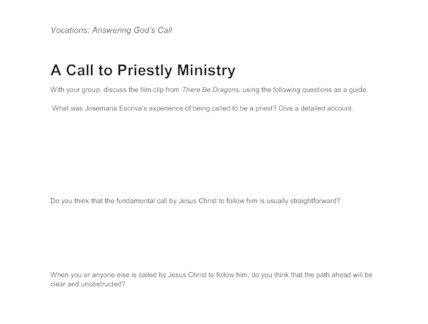
This resource is a discussion guide and worksheet about the call to priestly ministry based on the film clip from There Be Dragons.
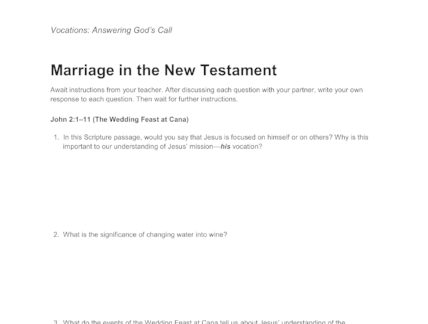
A discussion-oriented worksheet on marriage in the New Testament.
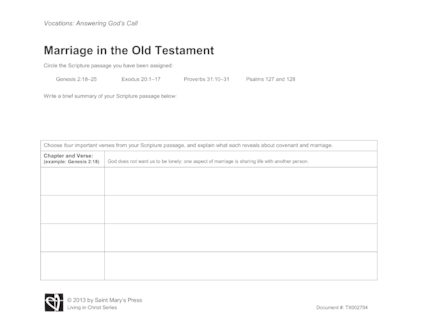
An activity that takes a look at marriage in the Old Testament.
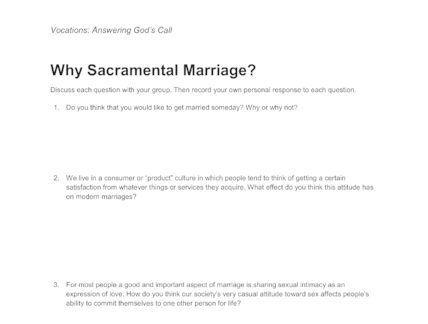
A series of short questions on Sacramental Marriage to discuss with a group, or personally respond to.

A series of questions to guide you through a discussion of the single life, whether temporary or permanent.
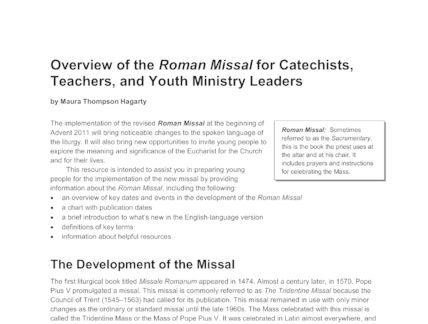
This resource is intended to assist you in preparing young people for the implementation of the new missal.
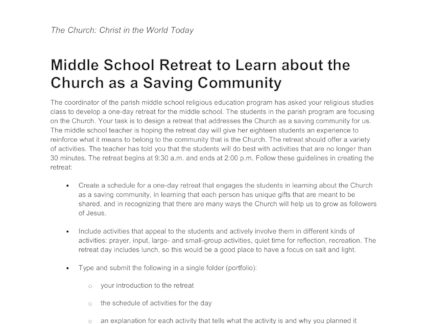
An outline to help plan a middle school retreat focused on the Church as a saving community.
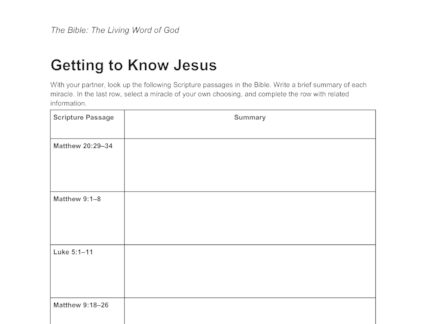
A partner activity on getting to know Jesus through Scriptural accounts of his miracles.
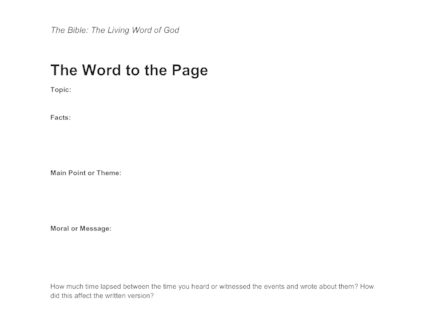
A worksheet on the topic, facts, main point or theme, and moral or message of a chosen event.
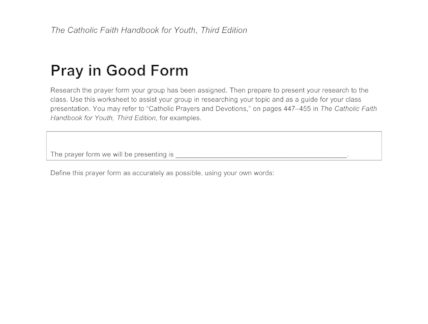
A worksheet, from "The Catholic Faith Handbook for Youth" Teacher Guide, to assist students in researching and presenting different prayer forms.
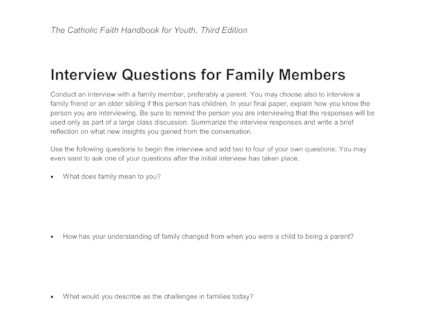
Several interview questions for family members on family life and the Fourth Commandment.
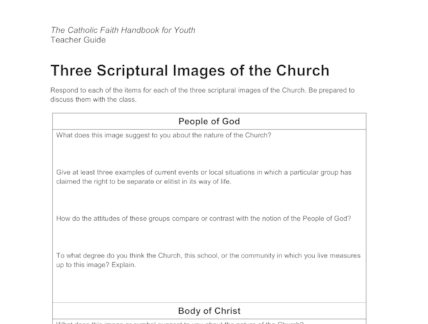
An activity where students are asked to respond to each of the items for each of the three scriptural images of the Church.
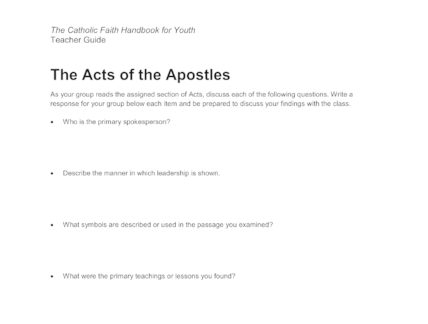
A group activity where students are asked to read assigned sections of Acts of the Apostles, and discuss the presented questions.
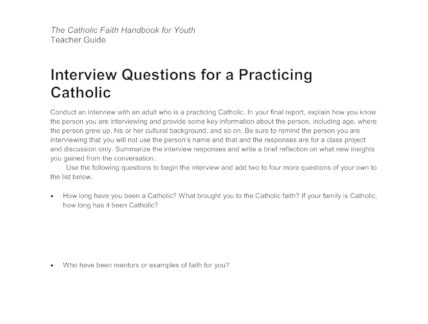
A list of interview questions to ask a practicing Catholic.
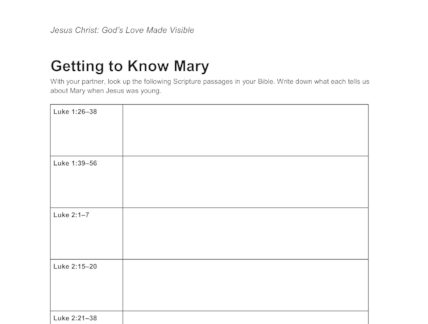
A partner activity where Scripture passages are used to get to know Mary.
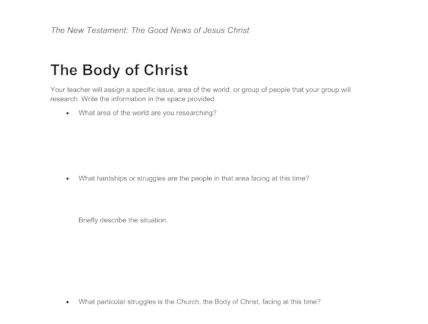
A customizable assignment on different issues, locations, and groups of people around the world, in relation to the Church, the Body of Christ.
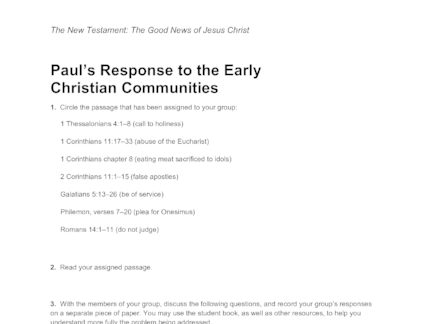
A group assignment on Paul’s response to the early Christian communities.

A series of questions on the Apostles Peter and Paul, to be answered in a small group.
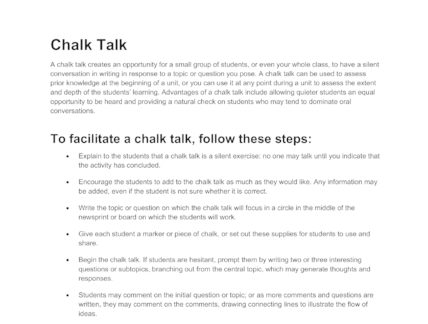
Steps on how to facilitate a silent conversation in writing in response to a topic or question posed.
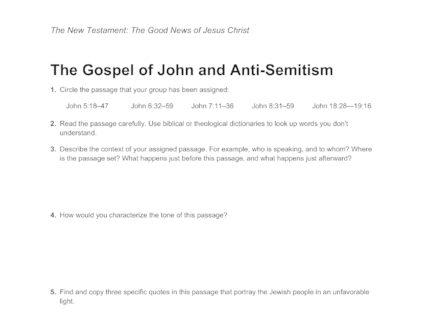
A group activity on the Gospel of John and anti-Semitism.
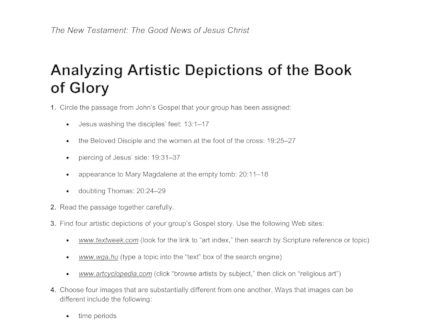
A group activity where students analyze the artistic depictions of the Book of Glory.
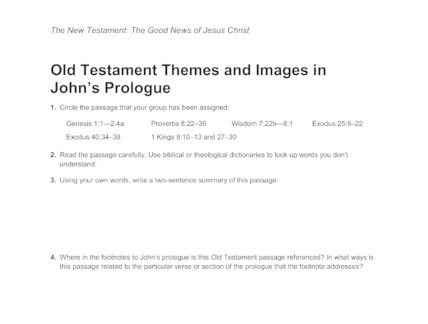
A worksheet on the Old Testament themes and images in the prologue of the Gospel of John.
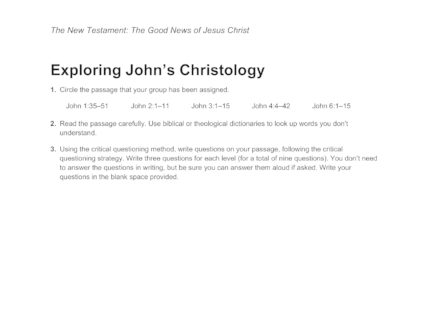
A worksheet where the critical questioning method is used to explore John’s Christology.
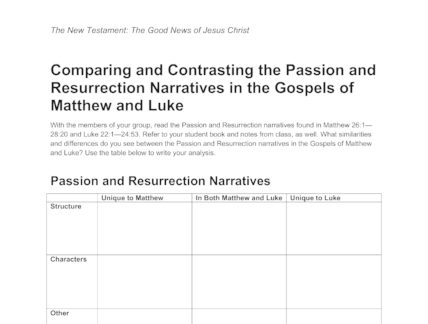
A group worksheet on comparing and contrasting the Passion and Resurrection narratives in the Gospels of Matthew and Luke.
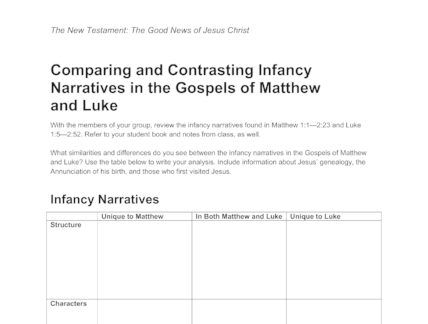
A group worksheet on comparing and contrasting infancy narratives in the Gospels of Matthew and Luke.
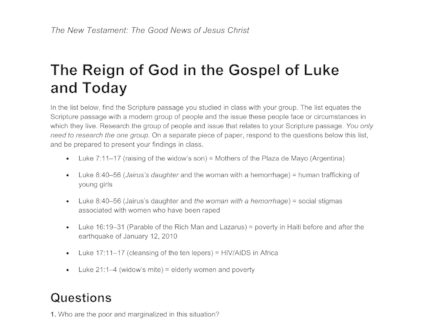
A group worksheet on how the Reign of God is presented in the Gospel of Luke and in today’s culture.
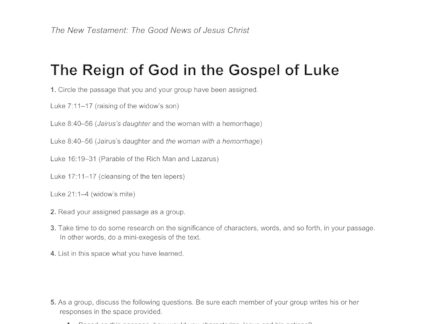
A group worksheet on how the Reign of God is presented in the Gospel of Luke.
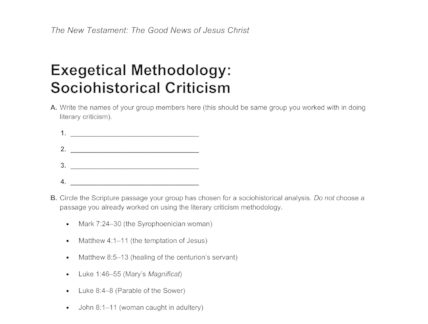
A group assignment on exegetical methodology: sociohistorical criticism.
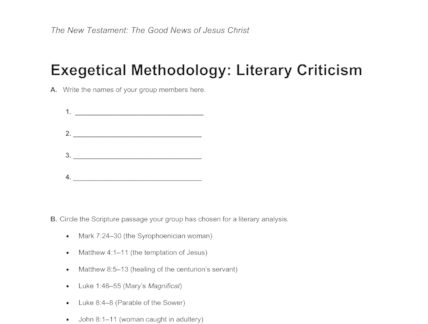
A group activity on using exegetical methodology to analyze Scripture.
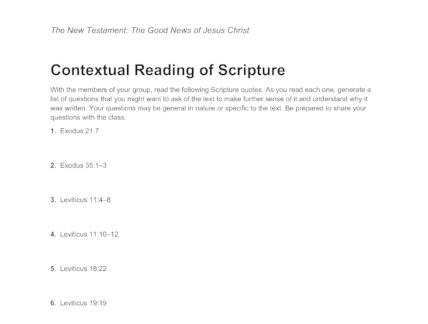
An activity where students read selected Scripture quotes and generate a list of questions that they want to ask of the text to further understand why it was written.
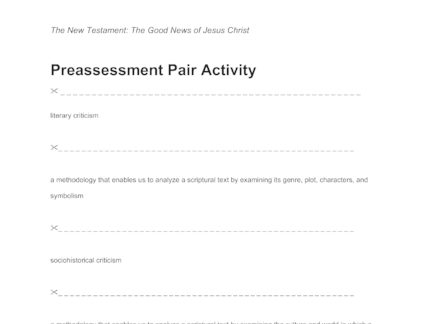
A preassessment activity where students work in pairs to match definitions and vocabulary words.
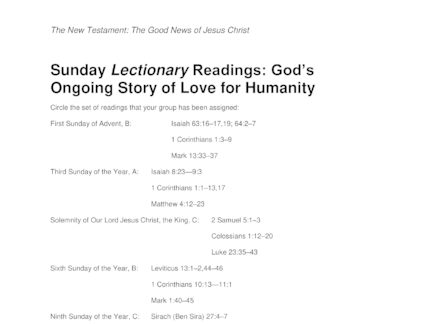
A group assignment on several sets of Sunday Lectionary readings.
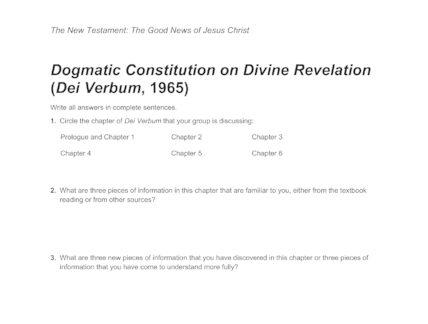
A worksheet that examines several chapters of "Dei Verbum" using group discussion.
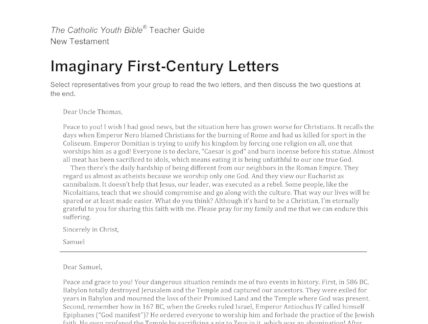
Two imaginary first-century letters that describe the difficulties of staying faithful to the teachings of Jesus in a culture that rejects them.
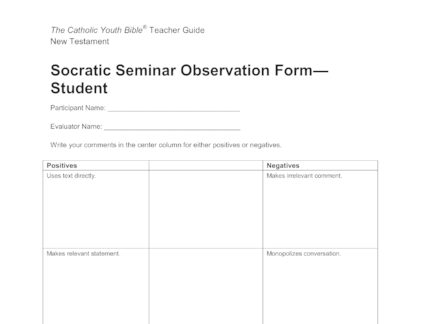
An observation form for students to fill out after a Socratic Seminar.
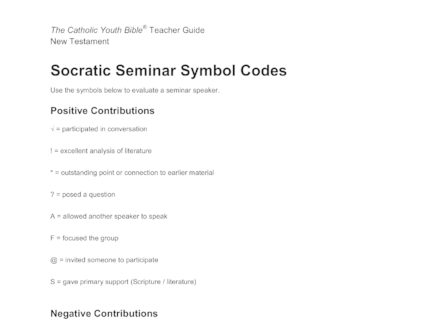
A list of symbol codes used to evaluate the Socratic Seminar method.
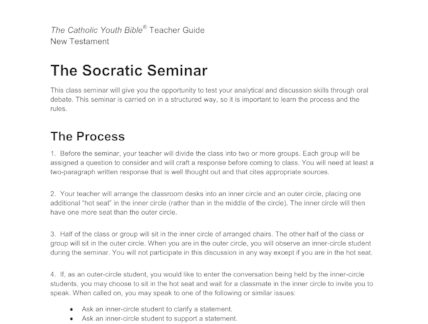
A handout on the Socratic Seminar method, which is a class seminar that gives students the opportunity to test their analytical and discussion skills through oral debate.
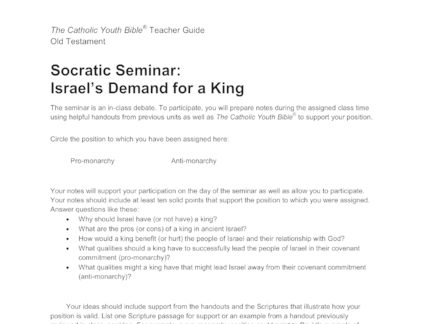
Instructions for an in-class debate on Israel’s demand for a King.
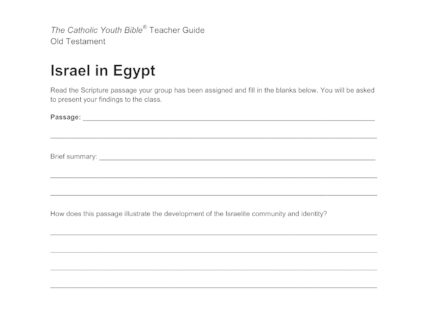
A worksheet where students are asked to work in groups to read Scripture passages that illustrate the development of the Israelite community and identity.
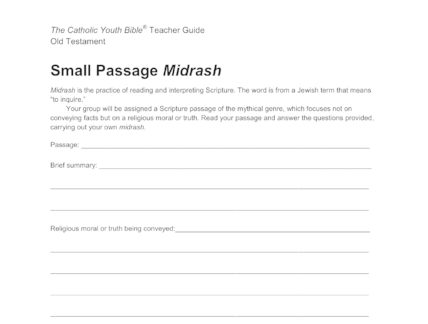
An activity where students read an assigned Scripture passage of the mythical genre and then work on interpreting what they have read, from “The Catholic Youth Bible” Old Testament Teacher Guide.
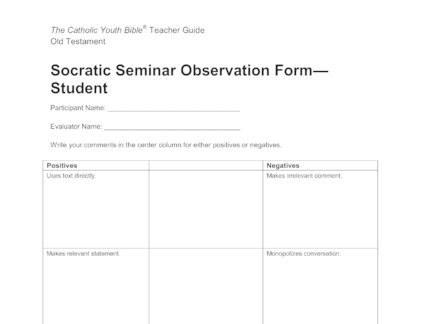
A student observation form for the Socratic seminar debate method.
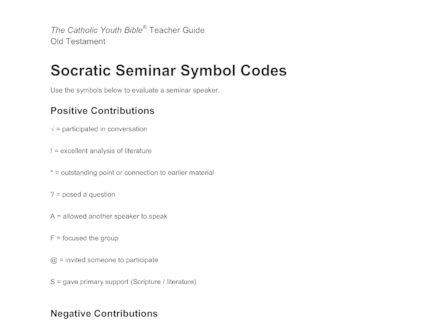
Socratic seminar symbol codes to help quickly evaluate a seminar speaker.
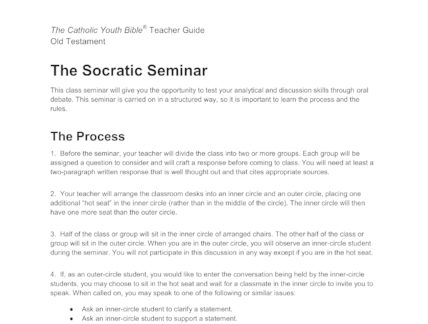
A reading on the process and expectations for the Socratic Seminar debate.
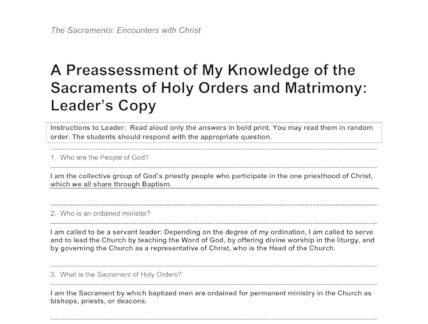
The leader’s copy of several preassessment questions and answers used to gauge students’ knowledge of the Sacraments of Holy Orders and Matrimony.
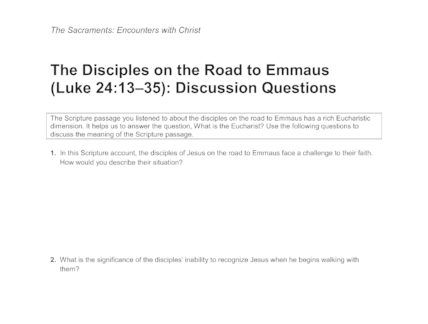
Discussion questions based on The Disciples on the Road to Emmaus (Luke 24:13-35).
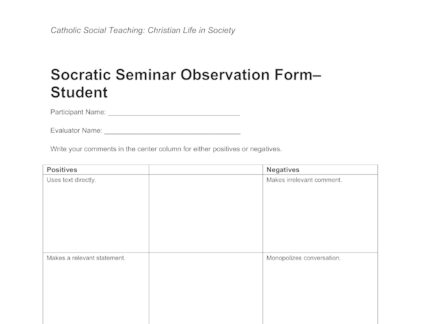
A student observation form for the Socratic seminar.
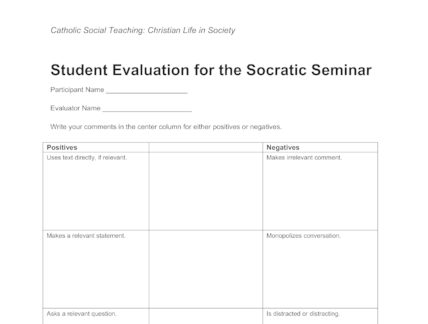
A student evaluation sheet for the Socratic seminar.
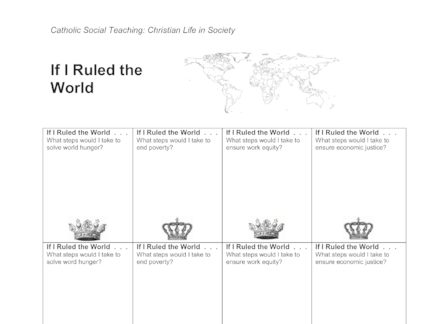
A worksheet that asks students to think about how they would solve different social justice issues if they ruled the world.
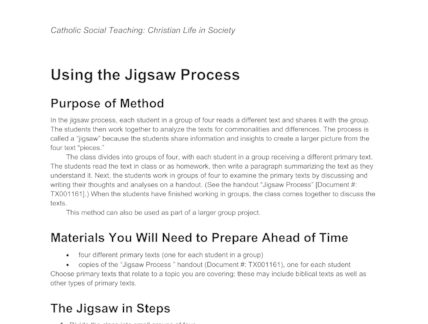
A resource on how to use the jigsaw process, with is a method where students share information and insights from different readings to create a larger picture.
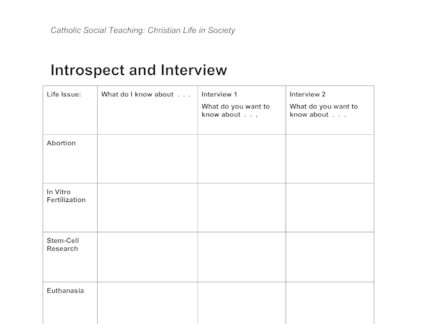
A worksheet on introspect and knowledge gained from interviews on important life issues including abortion, in vitro fertilization, stem-cell research, euthanasia, the death penalty, and immigration.
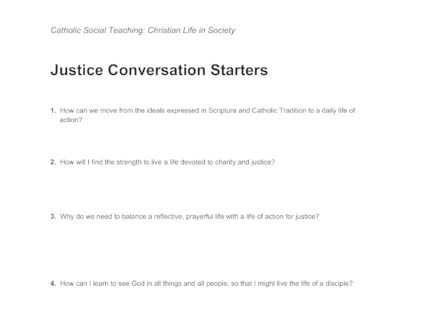
A list of several conversation starters or self-reflection questions on the topic of justice.
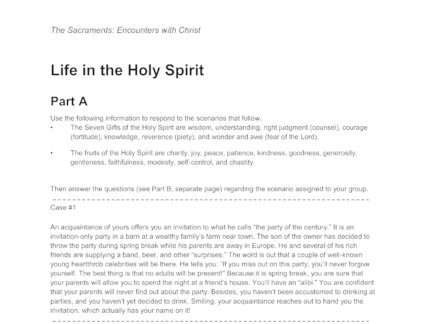
A number of real-world scenarios that deal with the Seven Gifts of the Holy Spirit and the fruits of the Holy Spirit.
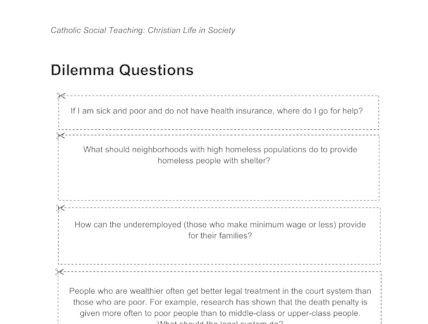
A set of questions based on real-world situations and dilemmas that a person may be dealing with.
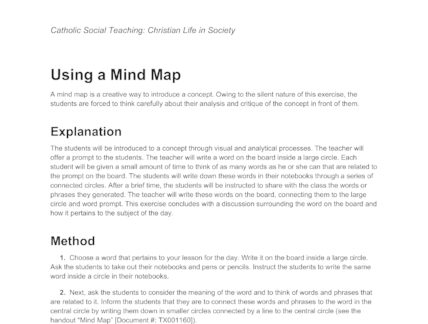
A reading on using a mind map, which is a creative way to introduce a concept.
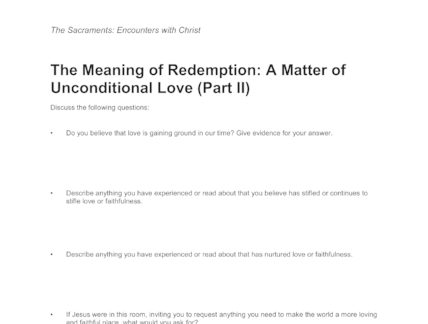
A set of discussion questions centered around the meaning of Redemption: a matter of unconditional love, from "The Sacraments: Encounters with Christ."
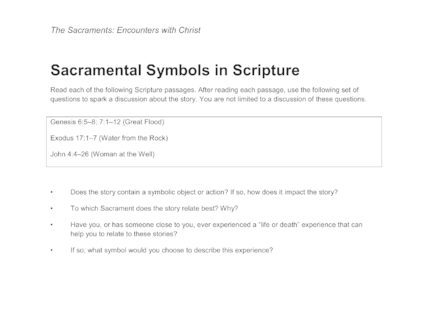
A listing of scripture passages and complementary discussion questions from “The Sacraments: Encounters with Christ.”
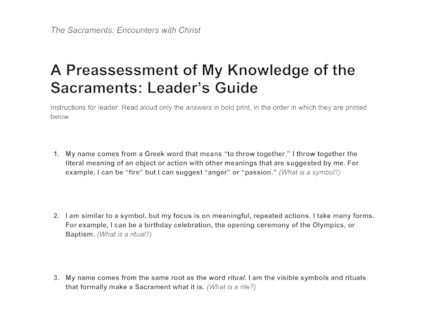
The Leader’s Guide for a preassessment of students’ knowledge of the Sacraments.
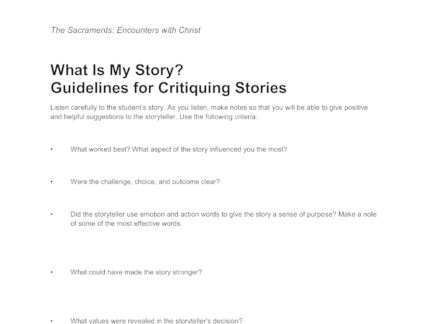
Guidelines for critiquing “What is My Story?” from “The Sacraments: Encounters with Christ.”
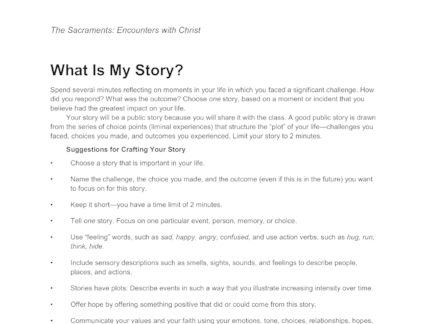
An activity based on reflecting on moments in your life in which you faced a significant challenge, from “The Sacraments: Encounters with Christ.”
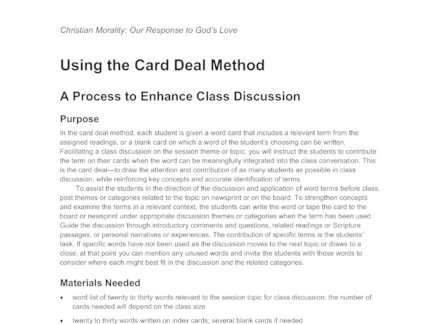
An instructional guide for using the card deal method, from "Christian Morality: Our Response to God's Love."
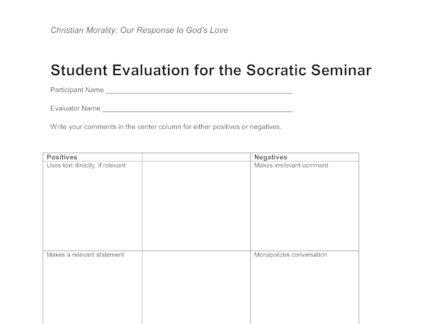
A student evaluation form for the Socratic seminar.
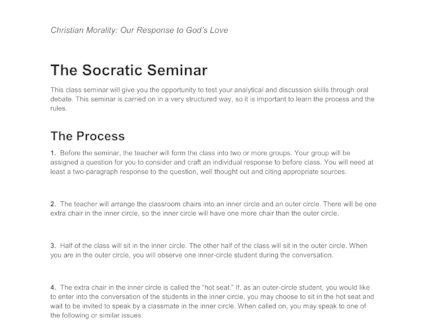
This class seminar will give you the opportunity to test your analytical and discussion skills through oral debate. This seminar is carried on in a very structured way, so it is important to learn the process and the rules.
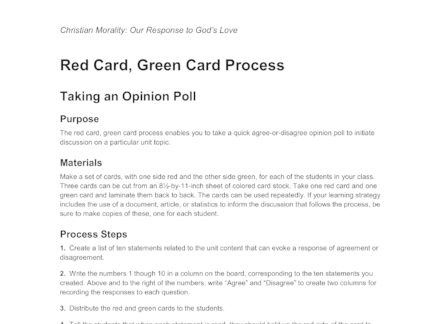
The red card, green card process enables you to take a quick agree-or-disagree opinion poll to initiate discussion on a particular unit topic.
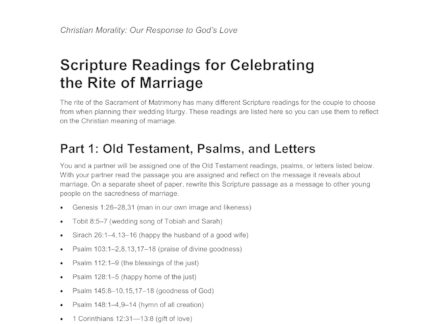
A list of Scripture readings that can be included in celebrating the Rite of Marriage, from "Christian Morality: Our Response to God's Love."
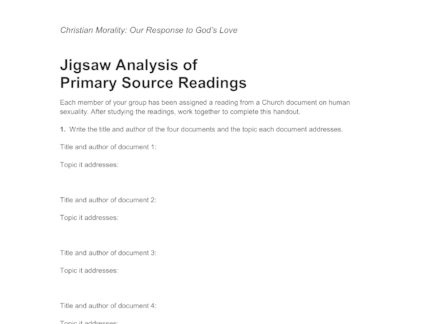
A group activity dealing with the concept of human sexuality, from "Christian Morality: Our Response to God's Love."
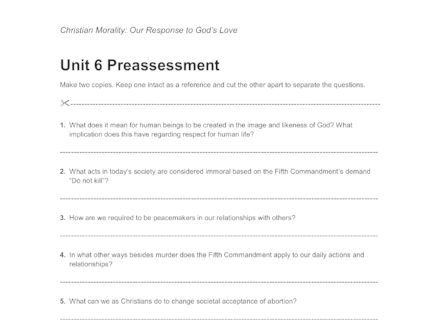
A preassessment for Unit 6 of "Christian Morality: Our Response to God's Love."
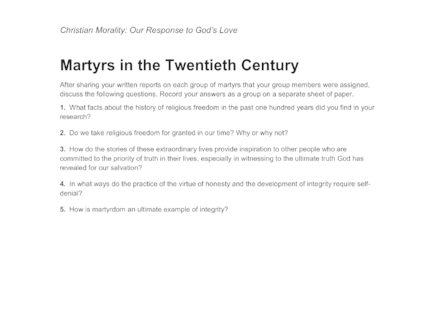
A group discussion sheet on martyrs in the twentieth century, from "Christian Morality: Our Response to God's Love."
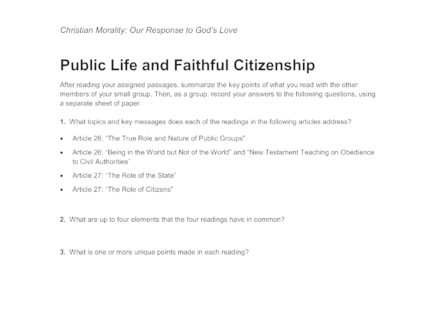
Group discussion questions, based on a reading assignment, on public life and faithful citizenship, from "Christian Morality: Our Response to God's Love."
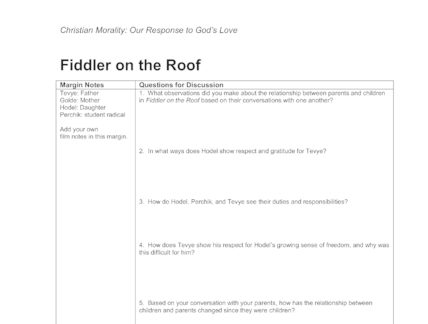
Questions for discussion for "Fiddler on the Roof" from "Christian Morality: Our Response to God's Love."
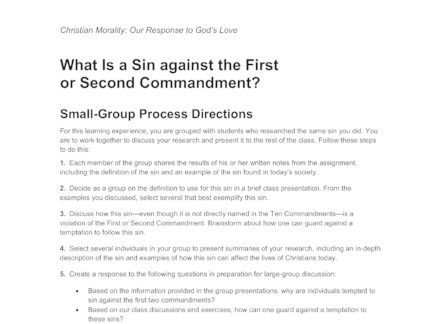
A small group activity on sins against the first and second commandment, from "Christian Morality: Our Response to God's Love."
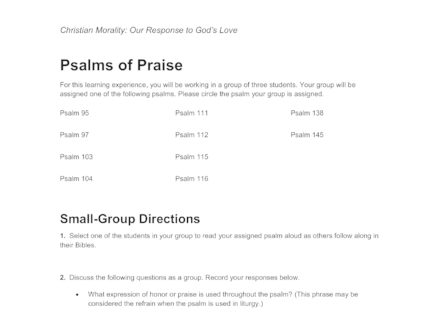
An activity dealing with the Psalms of Praise, from "Christian Morality: Our Response to God's Love."
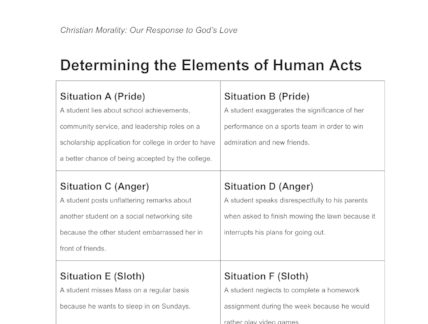
A worksheet on determining the elements of human acts from "Christian Morality: Our Response to God's Love."
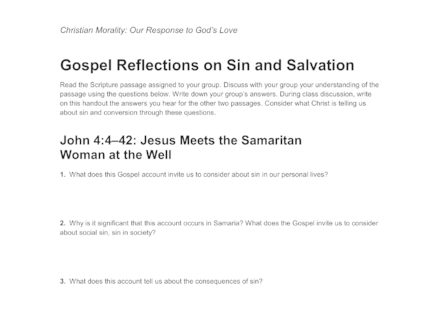
A Gospel reflection on sin and salvation from "Christian Morality: Our Response to God's Love."
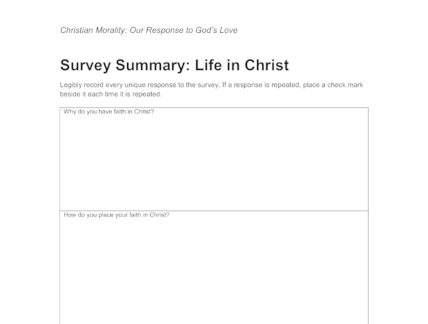
A survey summary for "Christian Morality: Our Response to God's Love."
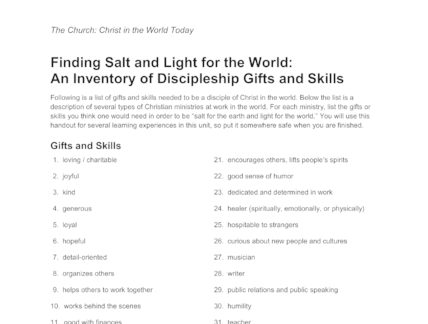
This worksheet is part of the Living in Christ Series. It helps students reflect on various gifts, skills and virtues they might posesses in order to discern specific ministries they might be good at.
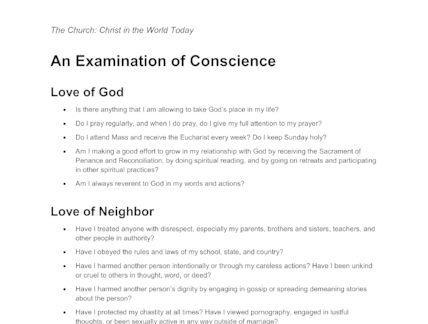
This resource is part of the Living in Christ Series. It offers great reflection questions for going through an examination of conscience, dividing the questions into those referring to love of God, and those referring to love of neighbor. This …
This PowerPoint is part of the Living in Christ Series. Rather than a philosophical or theological discussion of the mystery of suffering, this resource asks students to meditate and think about Jesus' example of suffering for people he loves.
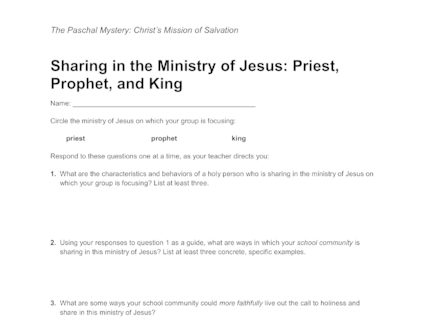
This activity is part of the Living in Christ Series. Groups of students can answer questions about Jesus as Priest, Prophet or King and reflect on models and characteristics of these distinct but related ministries.
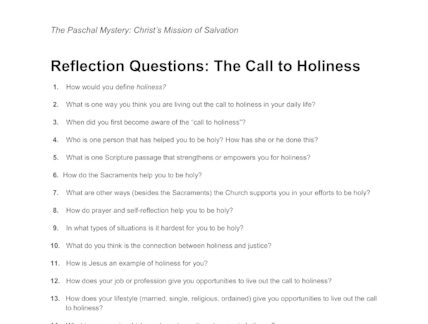
This activity is part of the Living in Christ Series. Students can reflect on what it means to be holy and how to grow in holiness through these series of questions.
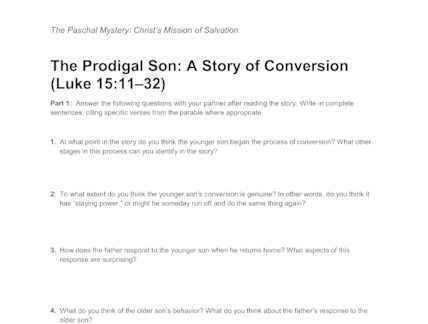
This worksheet is part of the Living in Christ Series. Students can reflect on and answer questions about the conversion of the Prodigal Son.
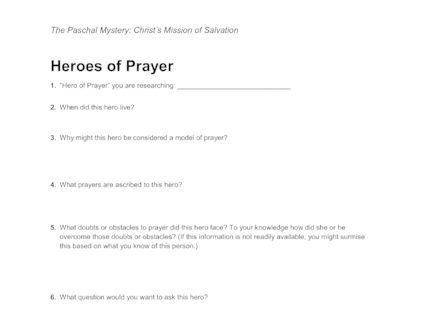
This activity is part of the Living in Christ Series. Students are asked to research and answer questions about a "Hero of Prayer", including doubt they experienced and prayers they used.
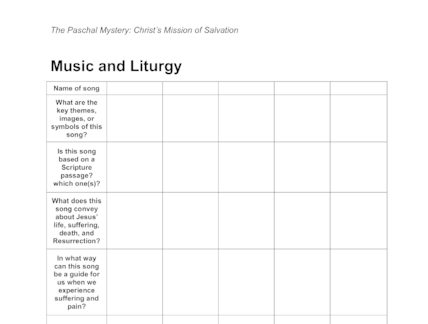
This activity is part of the Living in Christ Series. Students can reflect on various songs and pieces of music in the liturgy to come to a greater understanding.
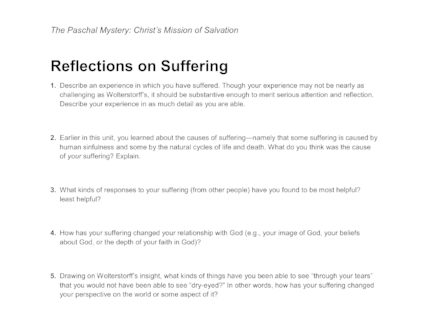
This activity is part of the Living in Christ Series. Students can reflect on their experiences of and response to suffering through this series of though-provoking questions.
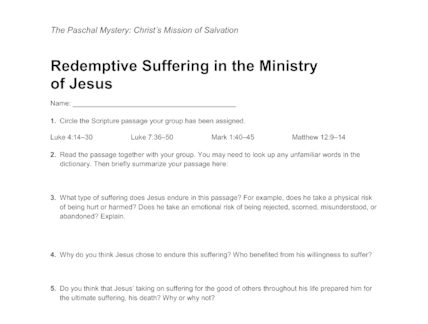
This worksheet is part of the Living in Christ Series. Students must look up various scripture passages referring to Jesus' suffering and answer questions about the scenario and the significance of redemptive suffering.
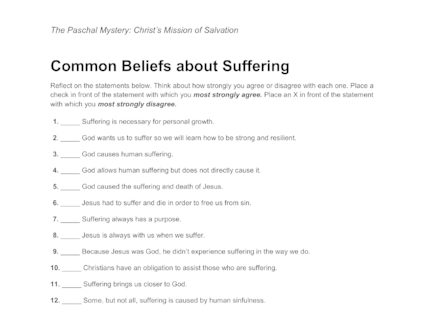
This activity allows students to reflect on a series of questions about human suffering and God's participation in it. They can agree or disagree with various statements of commonly held beliefs about suffering.
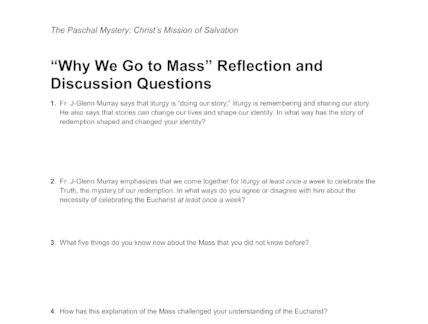
This activity is part of the Living in Christ Series. Students are asked to reflect on and discuss the significance of the Mass through these questions.
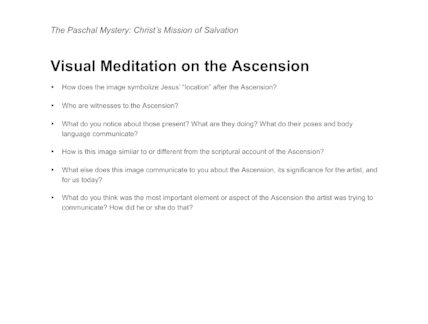
This activity is part of the Living in Christ Series. Students may reflect on images of Jesus' Ascension and answer these questions.
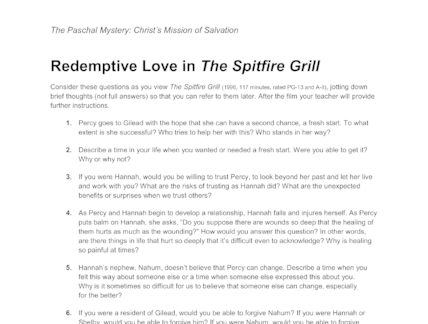
This worksheet is part of the Living in Christ Series. Students can answer questions about the themes and characters in the movie, "The Spitfire Grill".
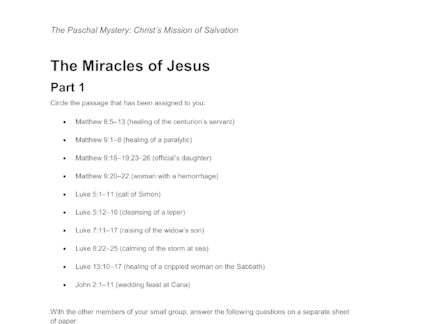
This activity is part of the Living in Christ Series. Students can work in groups to look up passages of some of Jesus' miracles and reflect on them together.
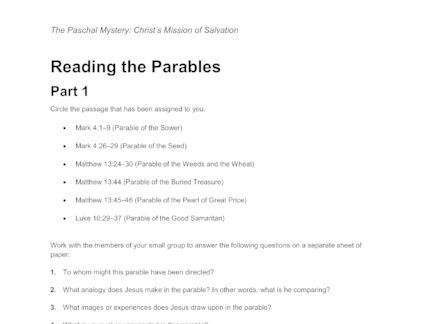
This activity is part of the Living in Christ Series. Students must look up some of Jesus' parables and answer questions about the analogy and imagery used and the message being given about the Kingdom of God.
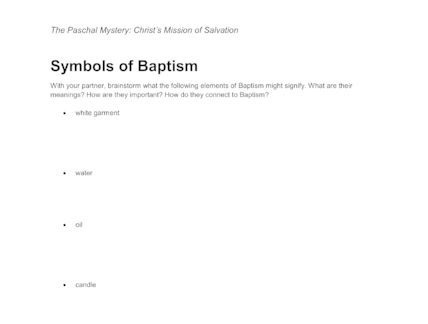
This activity is part of the Living in Christ Series. It invites students to reflect on the significance of key symbols used in baptism.
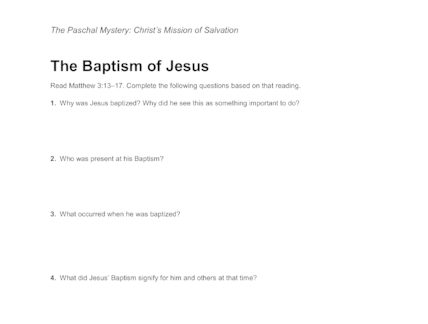
This activity is part of the Living in Christ Series. Students can read the account of Jesus' baptism and answer questions about it.
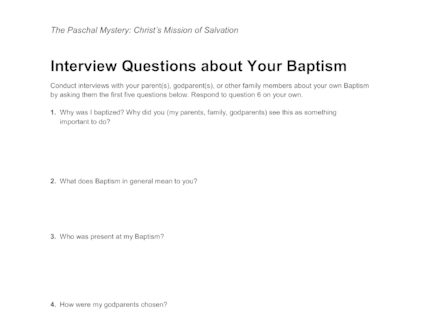
This activity is part of the Living in Christ Series. Students ask the provided to questions to adults who can tell them about the details of that student's baptism. A reflection on the significance of the sacrament is done at …
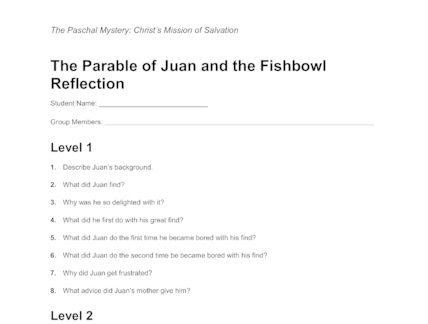
This activity is part of the Living in Christ Series. Students can answer basic, advanced, and highly reflective questions about the story.
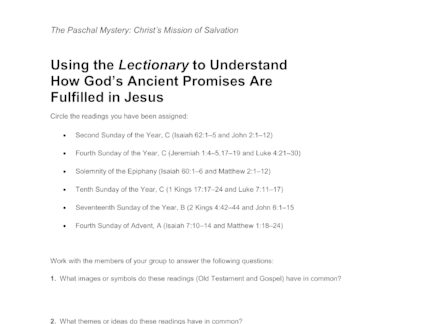
This activity is part of the Living in Christ Series. Students can use this handout to explore some Old Testament prophecies that find their fulfillment in Jesus Christ.
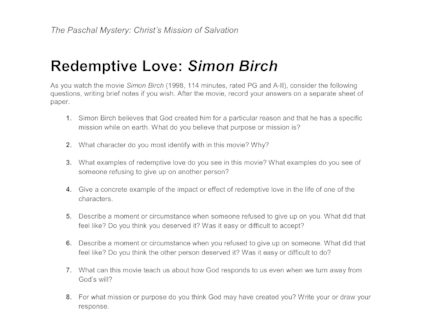
This activity is part of the Living in Christ Series. Students watching the movie "Simon Birch" can use this handout to follow along and reflect on major themes in the film.
This PowerPoint presentation is part of the Living in Christ Series. It explores salvation history, the transmission of Divine Revelation, and the role of the Magisterium.
This PowerPoint is part of the Living in Christ Series. It asks students to reflect on what it means to be human and how Jesus models the way to live fully alive.
This PowerPoint is part of the Living in Christ Series. Students reflect on various Gospel parables through works of art that depict them. After viewing the art, students are asked to think about common themes.
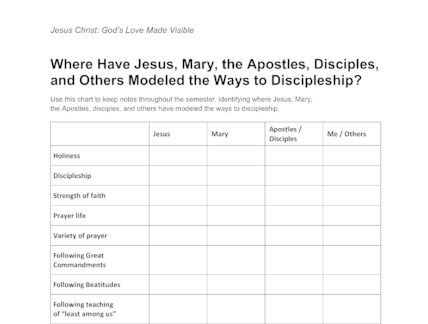
This activity is part of the Living in Christ Series. Students are asked to reflect on the discipleship modeled by Jesus, Mary, the Apostles, and others.
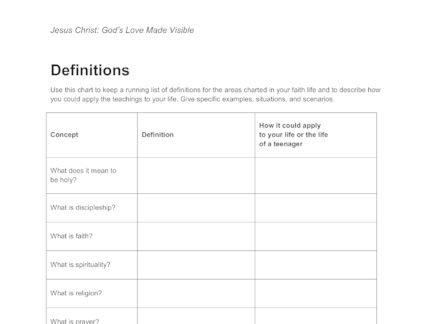
This activity is part of the Living in Christ Series. Students can use this chart to fill in the definiton of various terms, then find a practical application for their life.
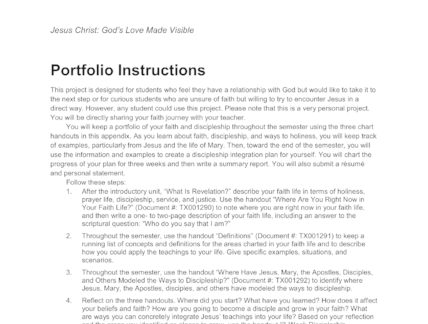
This resource is part of the Living in Christ Series. It offers instruction to students who must put together a portfolio of their readings, writings and assignments from lessons on Jesus and Christology.
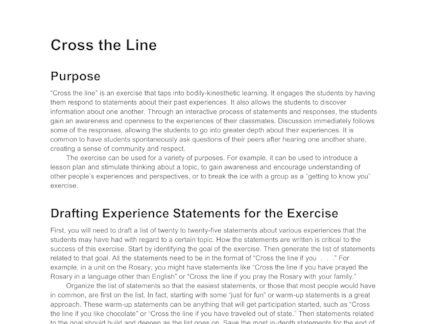
This article is part of the Living in Christ Series. It introduces a method of classroom discussion that is interactive and a part of the bodily-kinesthetic learning method. Students move to indicate their responses to various questions.
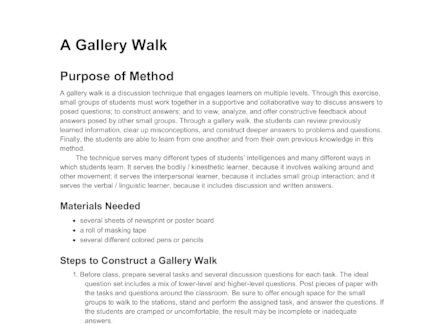
This article is from the Living in Christ Series. It is an instructional article for teachers to learn how to administer a "Gallery Walk" discussion technique.
This PowerPoint is part of the Living in Christ Series. It is a great introduction to what God desires from humans and why God chooses to reveal Himself to us.
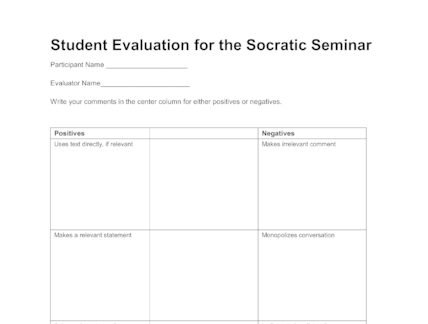
This rubric is part of the Living in Christ Series. Teachers may use it to evaluate students on their participation in a Socratic Seminar.
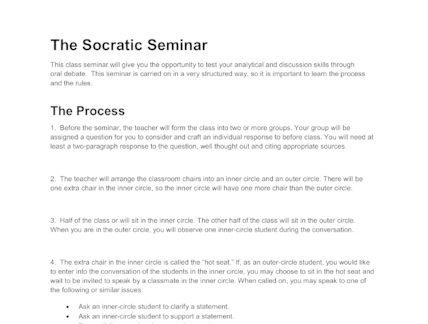
This article is part of the Living in Christ Series. Teachers may use it as a guide to using the Socratic Method in classroom discussion.
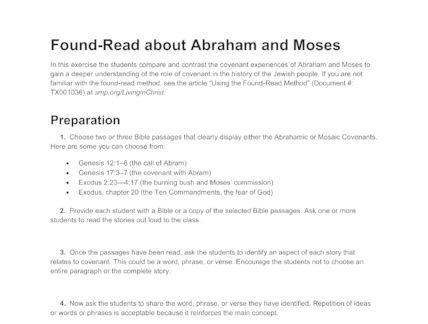
In this exercise the students compare and contrast the covenant experiences of Abraham and Moses to gain a deeper understanding of the role of covenant in the history of the Jewish people.
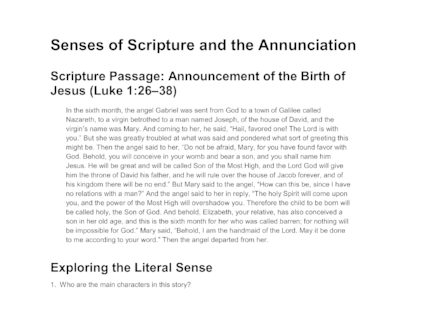
This activity is part of the Living in Christ Series. Students can analyze the story of the Annunciation through the literal, moral, spiritual, anagogical, and allegorical sense of interpretation.
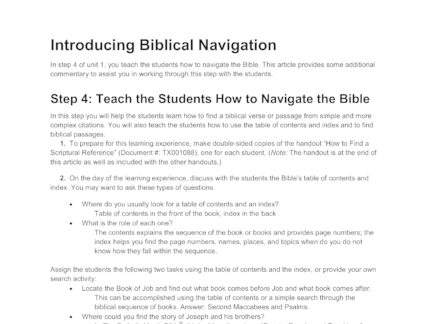
This article is from the Living in Christ Series. It offers guidelines for teachers teaching students how to navigate the Bible, including reference to other worksheet for the students.
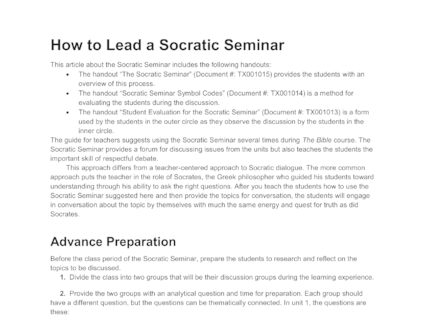
This article is part of the Living in Christ Series. It includes information on how to prepare for, lead, assess and follow-up the classroom use of a Socratic Seminar discussion method.
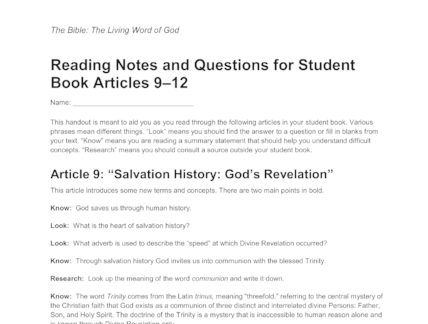
This reading guide is part of the Living in Christ Series. Students can use it while reading other articles from the LIC Series to take important notes and answer significant questions.
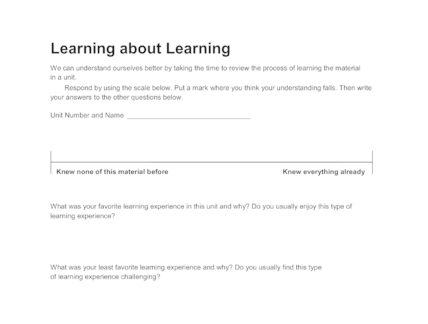
This worksheet is part of the Living in Christ Series. It asks students to reflect on their responses, likes, and dislikes to new learning methods.
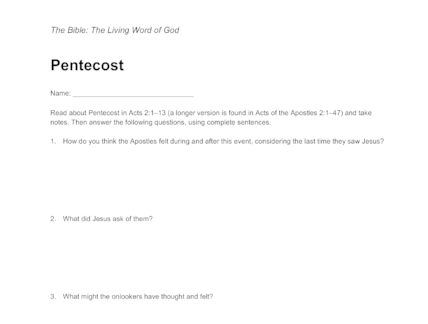
This activity is part of the Living in Christ Series. Students can read the account of Pentecost in the Acts of the Apostles and answer questions about it.
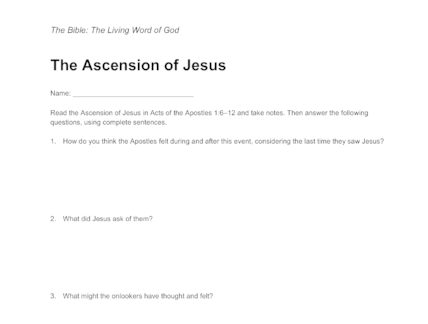
This worksheet is part of the Living in Christ Series. Students can read the account of Jesus' Ascension and answer questions about it.
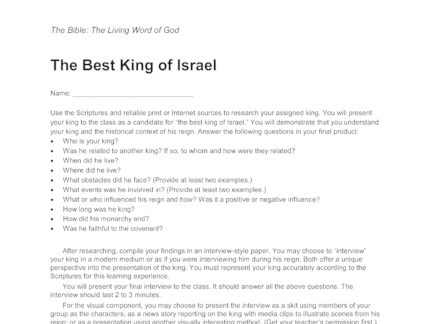
This handout is part of the Living in Christ Series. It outlines the research questions for students to explore while studying various kings of the Old Testament.
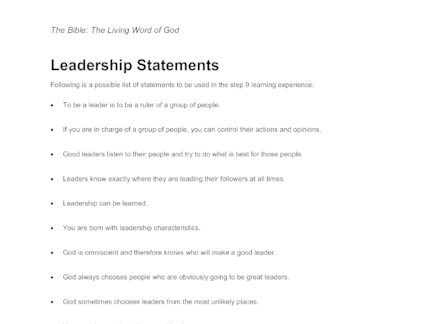
This worksheet is part of the Living in Christ Series. It includes several statesments about leadership in the Bible, including who's called, what skills are necessary, and what it takes to be a good leader.
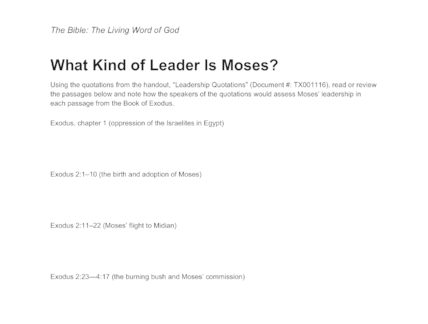
This activity is part of the Living in Christ Series. Students are asked to look up verses and make assessments about Moses' leadership in the Old Testament.
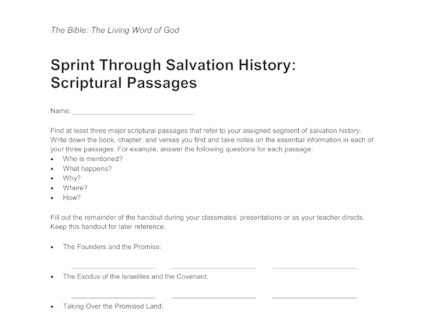
This activity is part of the Living in Christ Series. Students are asked to explore the Bible for key events in the Old and New Testaments in Salvation History.
This PowerPoint is part of the Living in Christ Series. It offers discussion points for a classroom where students can talk about faith, doubt, and reliable resources to know of God's existence.
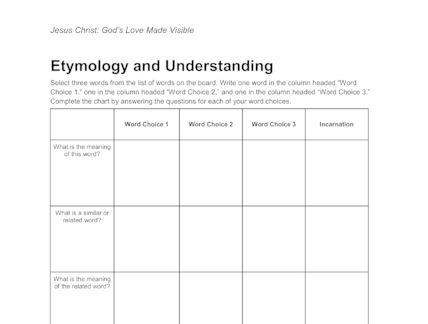
This activity is part of the Living in Christ Series. Students define, associate, and find similaries among various words that a teacher or catechist assigns, in order to see the root and relationship between them.
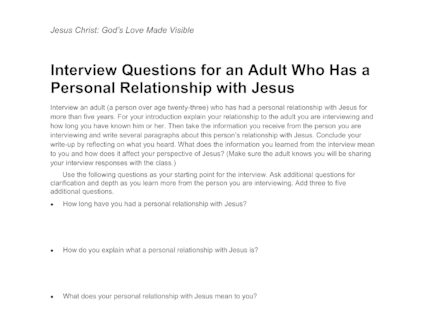
This activity is part of the Living in Christ Series. Students are to interview an adult in their life whom they know that has a personal relationship with Jesus.
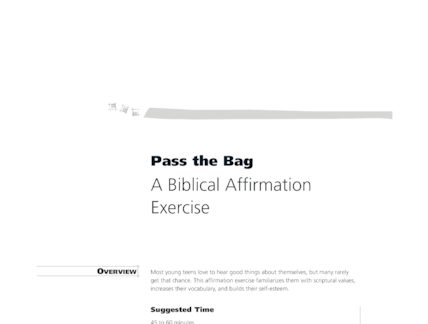
Class activity that familiarizes them with scriptural values, increases vocab, and ups self-esteem
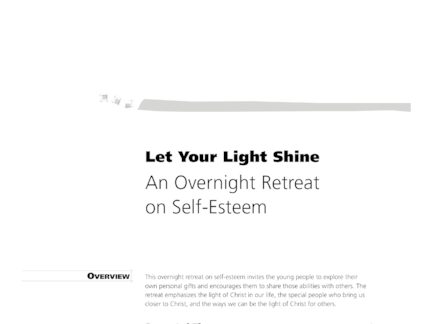
This overnight retreat on self-esteem invites the young people to explore their own personal gifts and encourages them to share those abilities with others. The retreat emphasizes the light of Christ in our Life, the special people who bring us …